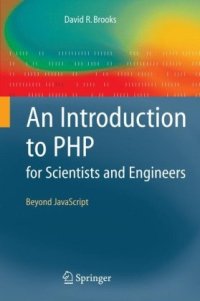
Ebook: Introduction to PHP for Scientists and Engineers: Beyond JavaScript
Author: David R. Brooks PhD (auth.)
- Genre: Computers // Programming: Programming Languages
- Tags: Programming Techniques, Programming Languages Compilers Interpreters, Science general, Popular Science in Mathematics/Computer Science/Natural Science/Technology, Engineering general, Physics general
- Year: 2008
- Publisher: Springer-Verlag London
- Edition: 1
- Language: English
- pdf
PHP, originally created in 1994 as a ‘Personal Home Page’ tool, is a server-side programming language that can be used to solve numerous computing problems that a client-side language like JavaScript cannot.
This highly useful text/reference presents key information needed to write your own online science and engineering applications, including reading, creating and manipulating data files stored as text on a server, thereby overcoming the limitations of a client-side language. This book focuses on those elements of the language - such as file input/output, arrays, built-in math functions, and user-created functions - that are essential for solving a wide range of scientific/engineering computing problems. It assumes a working knowledge of HTML, programming concepts, and JavaScript, C or a similar language.
Features:
• Offers a working knowledge of PHP, essential for server-side programming
• Includes detailed code examples to guide the reader
• Contains several complete applications that show how to take advantage of server-side programming capabilities
• Extremely accessible, and ideal for self-study
• Provides an author-supported supplementary website containing code examples (www.pages.drexel.edu/~brooksdr/DRB_web_page/BookCode/PHPBookCode.htm)
• Directly addresses the needs of engineers, scientists and working professionals by explaining precisely those components of PHP required
This concise applications-oriented text is an exceptional shortcut to learning the essentials of PHP and is ideal for self-study or course use.
Dr. Brooks has authored several successful Springer titles, including: Problem Solving with Fortran 90 for Scientists and Engineers; C Programming: The Essentials for Engineers and Scientists; and An Introduction to HTML and JavaScript for Scientists and Engineers.
PHP, originally created in 1994 as a ‘Personal Home Page’ tool, is a server-side programming language that can be used to solve numerous computing problems that a client-side language like JavaScript cannot.
This highly useful text/reference presents key information needed to write your own online science and engineering applications, including reading, creating and manipulating data files stored as text on a server, thereby overcoming the limitations of a client-side language. This book focuses on those elements of the language - such as file input/output, arrays, built-in math functions, and user-created functions - that are essential for solving a wide range of scientific/engineering computing problems. It assumes a working knowledge of HTML, programming concepts, and JavaScript, C or a similar language.
Features: - Offers a working knowledge of PHP, essential for server-side programming, - Includes detailed code examples to guide the reader, - Contains several complete applications that show how to take advantage of server-side programming capabilities, - Extremely accessible, and ideal for self-study, - Provides an author-supported supplementary website containing code examples (www.pages.drexel.edu/~brooksdr/DRB_web_page/BookCode/PHPBookCode.htm), - Directly addresses the needs of engineers, scientists and working professionals by explaining precisely those components of PHP required.
This concise applications-oriented text is an exceptional shortcut to learning the essentials of PHP and is ideal for self-study or course use.
Dr. Brooks has authored several successful Springer titles, including: Problem Solving with Fortran 90 for Scientists and Engineers; C Programming: The Essentials for Engineers and Scientists; and An Introduction to HTML and JavaScript for Scientists and Engineers.